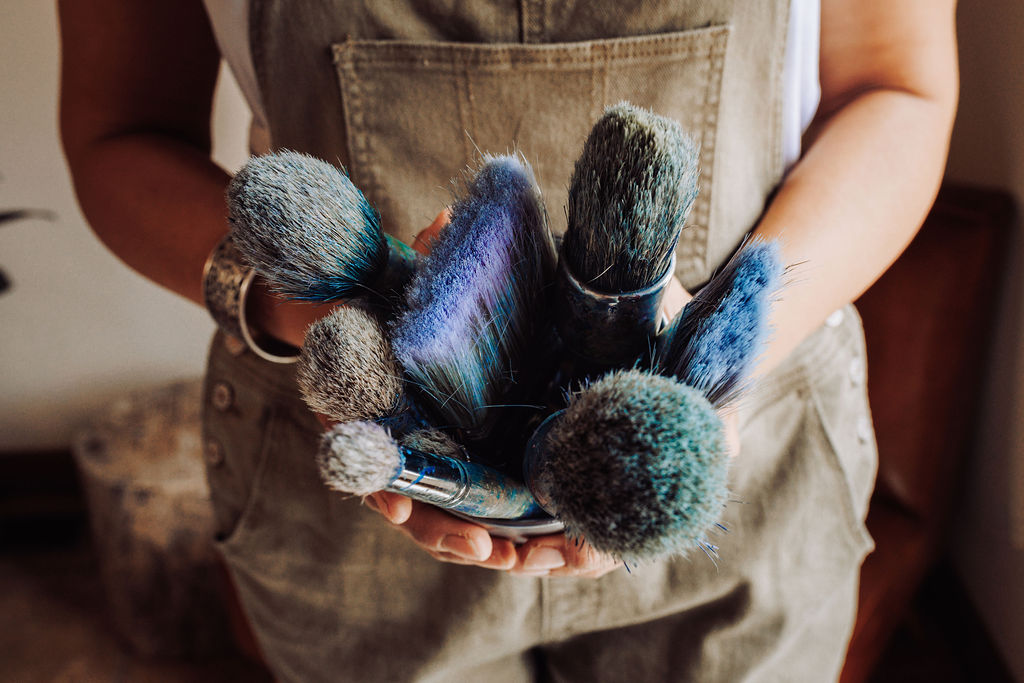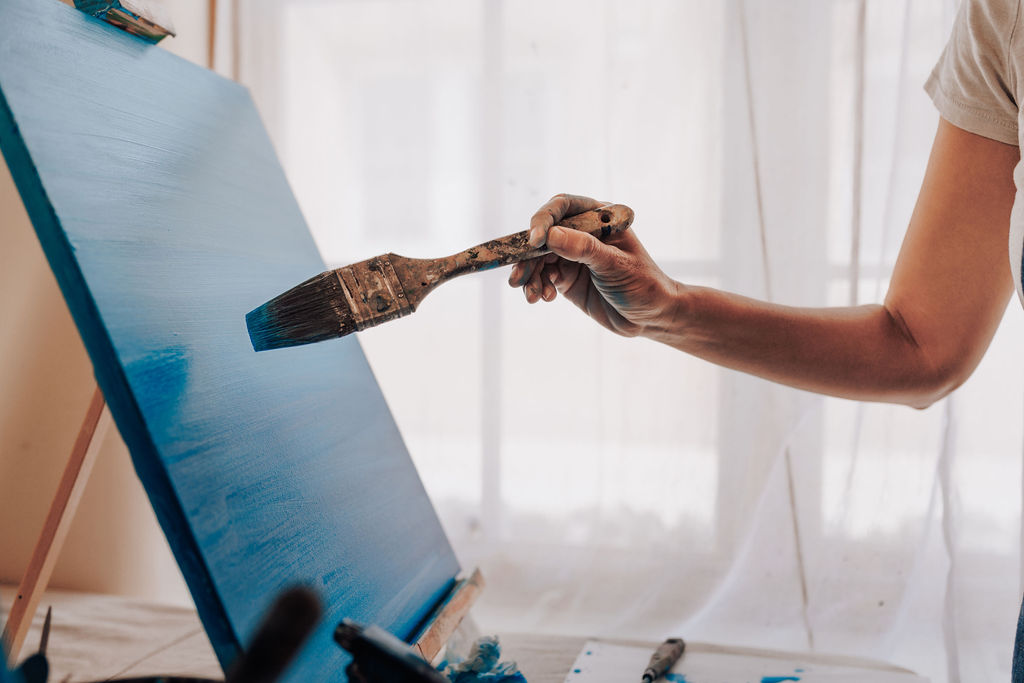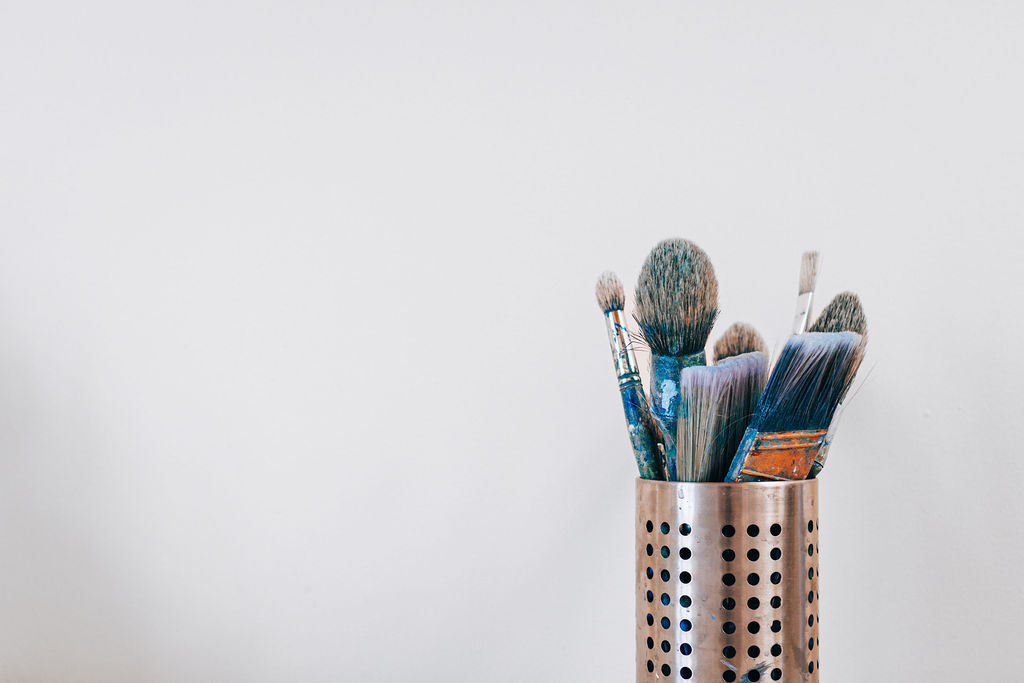When diving into the world of painting, one often wonders, “Does the quality of a paintbrush matter?” or “Does the price of a paintbrush matter?” The answer is both yes and no. While some argue that “you get what you pay for,” that’s not always the case. There are high-quality, expensive brushes worth every penny, but there are also excellent, affordable options available. In this blog post, we will explore how to identify a quality paintbrush, best practices for caring for your brushes, and my top picks for both splurge-worthy and budget-friendly options.
Prefer to watch the video tutorial? Click here!
Understanding Paintbrush Quality: Key Factors
To truly appreciate whether the price of a paintbrush matters, we must first understand what determines the quality of a paintbrush. Several factors contribute to a brush’s performance and durability, including the material, construction, and overall craftsmanship. Let’s look at each of these components:
1. Brush Material
First and foremost, brushes can be made from synthetic or natural bristles. Each type has its advantages, depending on the effects you want to achieve in your paintings.
- Natural Bristles: Made from animal hair, natural bristles are often preferred for oil painting due to their ability to hold paint well and maintain shape. Hog hair, for example, is excellent for creating bold, textured strokes, which is why I prefer it for abstraction.
- Synthetic Bristles: Typically made from nylon, polyester, or a blend, synthetic bristles are ideal for acrylics and watercolors. They are durable, easy to clean, and resistant to damage from solvents.
2. Brush Construction
Quality brushes are characterized by their smooth, consistent bristles without stray hairs. Key construction elements include:
- Flagging: The natural split ends of the bristles help hold more paint and provide a smoother application.
- Tapering: The gradual reduction in thickness of each bristle towards the tip allows for precise control and a finer point.
3. Bristle Retention
In addition to the material and construction, high-quality brushes have bristles that are securely embedded and do not shed easily. If you apply paint and bristles fall out, then you might consider returning or trashing the brush. Bristles in your painting from poor-quality brushes is frustrating, and you will have to remove them with tweezers. Brush retention is often ensured by a well-made ferrule, which brings us to our next point.

4. Ferrule
The ferrule is the metal part that holds the bristles to the handle. A high-quality ferrule should be seamless, rust-resistant, and tightly crimped to the handle, preventing wobbling and ensuring durability. To keep the ferrule in good condition, don’t keep paint brushes in water while you are working; instead, wash off the brush and lay in next to your palette.
5. Handle
Handles can be made from wood or acrylic. They should be comfortable to hold, well-balanced, and securely attached to the ferrule. A good finish on a wooden handle will protect it from swelling or cracking. Leaving brushes in the water while you are working will also lead to swelling and cracking, so be sure not to do this.
6. Spring and Snap
Another crucial factor is that a quality brush should have a good spring (the ability to return to its original shape) and snap (the ability to control paint flow). These characteristics are crucial for precise, consistent strokes. Spring and snap may not be as important if you paint loosely or abstractly, but will be important if you are a representational or precise painter.

9. Longevity
Investing in a quality brush can pay off in the long run. For instance, I’ve had my favorite brushes for over 20 years. While a $50 investment in a brush made many years ago might seem pricey, its longevity makes it worthwhile. Conversely, I’ve used my favorite inexpensive brush for about 1.5 years. I don’t expect it to last 20 years, but for $7, I will be happy if it lasts 3 years!
Best Practices for Brush Care
Regardless of the price, taking good care of your brushes is essential. Proper care extends the lifespan of your brushes and ensures they perform well. Here are some tips:
- Cleaning: Always clean your brushes thoroughly after each use. For oil paints, use a suitable solvent, while for acrylics and watercolors, water and mild soap work well. I prefer The Master’s Brush cleaner because in addition to cleaning, it also restores brushes, and comes in a convenient tub. Be sure to lay brushes flat after cleaning.
- Storage: Store brushes with bristles facing up to prevent damage and maintain their shape. Ensure the brushes are not crammed together in your container or they could alter their shapes.

- Handling: Avoid pressing down too hard on the brush to prevent splaying and damage to the bristles. You should never firmly push the tip of your brush at your painting surface; instead, use the side of your brush, or very gently use the tip so that you don’t spay the bristles.
Top Picks: Splurge-Worthy and Affordable Brushes
Now that we’ve covered what makes a quality brush and how to care for it, let’s look at some of my top picks.
Splurge-Worthy Brushes
- Princeton Catalyst Brushes: Princeton is known for their superior craftsmanship and durability, and these brushes do not disappoint. The Catalyst brushes are just the right firmness (not too soft, and not too stiff), and have excellent spring and snap. The brush is extremely well, constructed, with a strong ferrule and bristles that don’t splay or fall out. Highly recommended!
- Escoda Chungking Brushes: Priced at around $60 for the largest size, these brushes are worth the investment for serious painters. What I love about these brushes is how they are a nice mix between being soft enough to create subtle blending for things such as clouds, but have enough firmness for the dry brush technique. I also the round shape that tapers because it will allow you to create a wide variety of marks.
Affordable Brushes That Act Expensive
- Royal & Langnickel Zen Brushes: These brushes offer excellent performance at a budget-friendly price. They are on the soft side, but have a bit of firmness too. I love the filbert for painting clouds, and the liner brush for fine lines and details. So far the ferrule, snap and spring has been excellent, and I haven’t lost one bristle yet. For the $10 range, these brushes provided superior value!
- Blick Scholastic Wonder Brush: These are rather soft brushes, so if that’s whay you prefer, you will love these. They are very well-constructed, and after many years of use in years of art classes, they have help up surprisingly well.
For more brush and painting tools recommendations, check out my blog post “The Best Acrylic Painting Tools.” In this post, I describe my favorite canvases, palette knives, paint brands, brushes, and so much more!
By considering these factors and choosing the right brushes, you can enhance your painting experience and achieve better results. Is there an inexpensive or spurge-worthy brush you love? Share with me in the comments!
WANT TO LEARN MORE?
- Subscribe and get one of the FREEBIES below!
- PDF explaining How to Use My 5 Favorite Mediums
- Ebook on How to Move From Representational Painting to Abstraction: 5 Transformative Art Lessons
- 8 Colors Every Artist Should Have: My list of BEST colors to buy and pro mixing tips
- Check out My Online Abstract Painting Course
- Read More Painting Tips Blog Posts
- Check out My Paintings & Art Prints for Sale
- Follow Me On YouTube, Instagram, or Pinterest
ABOUT ANDREA CERMANSKI
I am an artist out of Santa Fe, New Mexico who has been painting for almost 30 years. I love to teach first-timers as well as experienced painters who need a creative reboot. My work has been displayed in several galleries around the country, and I have a Bachelor’s in Art History, a Master’s in Art Education, and had my work in a show juried by Judy Chicago. The idea of getting more people painting makes me light up as I want to inspire more people to express their creative selves and tap into a place of joy and calm.